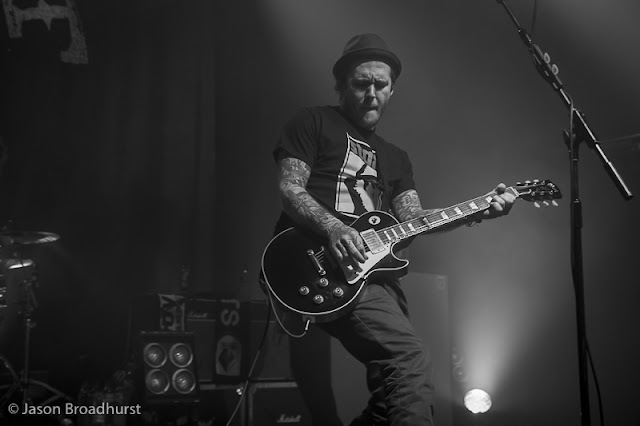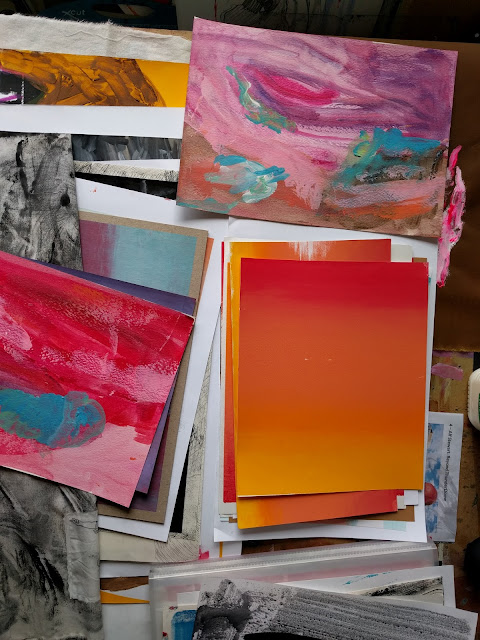I want to reconcile my ongoing art project A Film We're All Writing with my current and future plans to develop my studio practice into an eco-fashion line.
The setting for A Film We're All Writing is a landscape that reflects the character's emotions. I try to put the landscape across in a way that it can be read as an emotion, through colour, text or imagery. I feel this provides a lot of aesthetic and tactile scope when designing garments. The thought of dark clouds setting in or hot desert winds sweeping red dust across the horizon fill the mind with not only colours but with certain ideas for practical clothing. Swathes of fabric or a deep cotton hood could protect against the wind and the sun, and re-fashioned army surplus items could provide shelter from rains. The following passage I wrote to introduce one of my characters into The Swaglands and It gave me so many ideas for textiles and clothing: "Lone Cowgirl rides up a desert rain storm arriving in the night at a campfire site. She sleeps in the damp sand with her horse breaking the elements next to her, the fresh air cooled by the storm in the dark. She wakes to a wild desert sun baking the earth's floor dry"
In my observations and research from here in the UK I have noticed and learned various coping mechanisms people adopt in difficult situations such as displacement, environmental degradation and food shortage etc. Such coping mechanisms include humour and irony. The characters in A Film We're All Writing display some of these behaviours, particularly SidAlf with his installation/motel/joke The Parodize Motel.
I am going away in a month or so to research ethical and environmental fashion and textiles as well as sustainable local business models. Alongside my plans to turn my studio practice of eco-friendly art, printmaking and garment making into an actual eco-fashion line, I plan to write and keep a blog of my observations and research experiences to act as learning tool for those interested in or new to sustainable fashion and culture.
As I continue to design and make textiles and garments I will always keep the characters I have invented in mind, sometimes portraying their individual situations and thoughts. The Swaglands, being the fictional land that A Film We're All Writing takes place in, will always be the fictional land in which my clothing will evolve from. The Swaglands, is, in essence my studio!
I'm hoping to delve further into some of my characters as I visit their true homelands, such a the Australian outback and the garment factories of South East Asia. A sense of place is something we all crave and feel very strongly when we experience it, so it is therefore a great way to learn but also a useful tool with which to enhance peoples' perceptions of certain communities and habitats and the troubles they face due to climate change and Globalisation. Perhaps the strong sense of place I felt in New Jersey is why I began to subconsciously write A Film We're All Writing when I was there. I was listening to music right in the places that it was written, and walked down the streets referenced in those songs, so I felt this kind of puzzle coming together. I also read about approaches to songwriting and one of the things that Brian Fallon (one of the musicians I went to see) said was that when he writes lyrics and music he has these glimmers of imagined stories and scenarios (often inspired by real people or events, or himself) and the trick is to find the clues as to WHY that imagined scenario or character is the way they are. The human psyche and its environment are ever entwined.
Now because I trained in graphic design i've been moulded into this analytical observer who break down everything I see and tries to find meaning or specific context in every element of a created product (be it a poster, a film, a song, a painting, a novel). So Brian's approach to songwriting appeals - it's kind of the reverse: it's searching for those clues and gathering those elements to tell a story.
So to me, that clue-finding process is very beneficial as a communicative device - not always necessarily in terms of factual information, but in terms of enticing someone to understand a specific atmosphere, emotion or scenario.
As I absorbed New Jersey I felt like I was in some imagined film and I was finally meeting the people and seeing the places i'd imagined - I'd worked out why everything was the way it was culturally, environmentally and socially. And then I realised I had a clear picture because I have all these clues from the songs.
So... in a reverse fashion, if someone can see a film, they can search for the clues and dismantle the elements of the film's scenario and context, to arrive at the reasons why things have happened a certain way.
For example, I can present a character in a situation, with certain behavioural habits and hints of that person's history... and with the right images and text the viewer can search into what they see and uncover the character's past and what has happened to them. So If I make a character who is a victim of climate change... a viewer can have a fun time deciphering the character and work out why and howthey became a victim. Making climate change fun, seductive and filmic. That is why I want to keep the characters, locations and scenarios of A Film We're All Writing always running through the stories and designs of my eco-fashion and eco-textiles designs. The Buffalo Carcass (one of the characters) is already a print I use a lot on my fabrics.
You may wonder why I even bother to ensure these narratives and characters run through my garment designs, couldn't I just make some upcycled clothes any old how or some plain organic cotton garments? Well no, because although I am on a mission to become truly sustainable, I also just love the atmospheres of the sub-cultures that compliment a sustainable attitude that rocks the fast-fashion boat (see my post on why punk rock is sustainable) and these atmospheres, as well as the sense of place I have spoken about, add so much to the message of sustainability and adaptability, and the mission of revolution (in fashion or elsewhere). The slow fashion movement is punk as hell, and I see in myself a market for more expressive eco-fashion. The emo and the punk-rocker inside me want skeletons print, provocative yet thoughtful statements and bright colours in my clothing. I don't want to wear long sleeved plain hemp shirts in beige and olive colours. Eco-fashion in my mind needs to be just a bid more rad and way more youthful.
So to summarise, these are the reasons A Film We're All Writing will always influence my garment designs:
1. To punk up eco-fashion so we don't all have to wear beige.
2. To give a sub-text to the whole fashion project, the characters, scenarios and locations offering other entry points and collaboration opportunities such as art and installation material.
3. To contextualise real life environmental and subsequent social issues within a 'fictional' set of characters and scenarios so as to better communicate to a younger, creative audience.
4. To provide that sense of place that can bring about innovative designs in terms of adaptability and resourcefulness as well as aesthetic style.
The third and fourth points are ones I will research first-hand and in great details over the next six months as I travel around visiting the various locations that inspired A Film We're All Writing.













































































